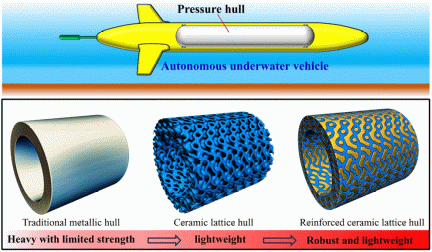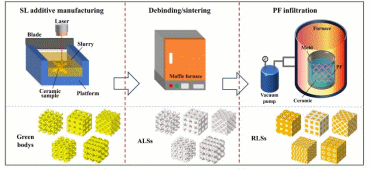
Ceramic Dot Matrix Structures and Ceramic Dot Matrix-Resin Composite Structures for Unmanned Submarine Applications (Image by the research group)

Preparation process of ceramic dot matrix-resin composite structure (Image by the research group)
Autonomous underwater vehicles (AUVs) are crucial scientific equipment for exploring the depths of the ocean. As AUVs venture to depths of up to ten thousand meters, the demand for their pressure resistance capabilities continues to rise. As vital components of AUVs, pressure hulls are characteristically thin-walled structures that demand a design approach focusing on high-pressure resistance and lightweight construction. Traditionally, metallic materials have been predominantly used for AUV pressure hulls. However, metal materials have reached their limits in terms of weight reduction, prompting an urgent shift toward the application of new materials.
Recently, the research team of Shenyang Institute of Automation(SIA), Chinese Academy of Sciences(CAS), designed and prepared a new reinforced lattice structure (hereinafter referred to as ceramic lattice-resin composite structure) composite of alumina ceramic lattice and phenolic resin through the additive manufacturing technology based on stereolithography and resin infiltration process. This new reinforced lattice structure combines the high strength and high modulus of ceramic material and the high toughness of resin material, which can achieve the combination of excellent mechanical properties and light weight.
The research team systematically characterised the mechanical response properties of ceramic lattice-resin composite structures with different configurations (SC, BCC, Gyroid, Oct, SchwarzP), relative densities and cell sizes under compressive loading, and also carried out numerical simulations using the Johnson-Holmquist-II (JH-2) model to predict and investigate their mechanical behaviour.
The results show that the compressive properties of ceramic lattice-resin composite structures are ranked as Simple Cubic (SC) > Body Centred Cubic (BCC) > Gyroid > Octo Truss (Oct) > SchwarzP (Sch). The mechanical properties of the ceramic lattice-resin composite structures were significantly improved with the increase of relative density and cell size.
The numerical simulation results are in high agreement with the experimental data, revealing the internal damage and crack extension mechanism of the material during compression. Compared with the conventional alumina lattice structures, the ceramic lattice-resin composite structure exhibits superior compressive strength (about 3 times improvement) and energy absorption performance (about 2.5 times improvement). This study provides a novel composite solution for the lightweight design of AUVs.
The research results were published in the international journal Thin-Walled Structures under the title Mechanical behaviour of reinforced Al2O3 lattice structures: Effects of structural parameters from experiments and simulations. Ke Zhong, a graduate student of Shenyang Institute of Automation (SIA), was the first author, and Jibin Zhao and Yuhui Zhao, both researchers of SIA, were the corresponding authors. This research was supported by the National Key Research and Development Programme of China, the National Natural Science Foundation of China, and the Youth Innovation Promotion Committee of the Chinese Academy of Sciences.
Link to paper: https://doi.org/10.1016/j.tws.2024.112753